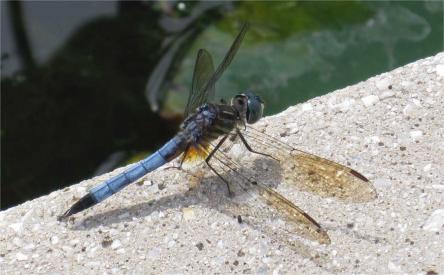This past summer, I was visiting the New York Botanical Gardens when serendipity struck: this beautiful little creature alighted on a stone railing around the edge of a pool, staying just long enough for me to snap this shot:
I think, though I’m not an expert, that this is a blue dasher, Pachydiplax longipennis.
I don’t usually like close-up photos of insects – they have an eerie, alien feel that I find disturbing. (I admit it, I’m a mammal chauvinist.) But this one is one of the rare exceptions. Looking at it again, it’s hard for me not to feel admiration for this sleek, graceful creature.
With its iridescent blue scales, its impossibly frail and transparent wings, its delicate jointed legs, it scarcely seems to belong to nature at all. It looks almost like a device, a tiny whirring clockwork machine made by some detail-obsessed jeweler – except, of course, that we humans haven’t yet learned to make machines of such fine and precise workmanship, nor any that pack so many marvelous capabilities into such a small package.
So much of its head is taken up by those huge, gorgeous compound eyes, it seems it has scarcely any room for a brain to process the information they take in. Yet dragonflies have keen eyesight, and are blurringly fast and acrobatic fliers – and imagine how well-tuned their organs of balance must be, to control their pitch, roll and yaw in three-dimensional space at such speeds, a task that would overwhelm a human vestibular system. And though they seem so clumsy, so fragile – adult dragonflies can only fly, not walk, and their wings can’t be folded in like a beetle’s but must be held out at all times – on their own small scale, they are fearsome and effective predators. And of course, like all living things, dragonflies have one more astounding ability that human-designed devices can’t match: they can make copies of themselves from the raw materials of their environment!
All in all, despite all our brains, we humans can’t create anything nearly as clever, as intricate, as adaptable, or as beautiful as a dragonfly. But we shouldn’t feel too bad: when it comes to forging machines, we’ve had barely a few hundred years of practice. Evolution has had hundreds of millions of years to refine its designs, to hone and sharpen them against the ruthless grindstone of natural selection. With that much of a head start, and with all the resources of a planet to use for trial and error, it’s no wonder that even this blind algorithm produces results of a beauty and craftsmanship we can’t match.
And yet, the stunning truth is that we ourselves are products of the same evolutionary process. Look at your hands, your arms, and imagine tens of millions of years of natural selection pushing and tugging on them like a sculptor kneading clay, slowly molding flesh and bone into new shapes. Imagine the skeins of DNA coiled in your cells, woven out of evolution like a tapestry from a loom. Imagine the unbroken chain of your ancestors stretching back into the misty recesses of time, each one only subtly different from the last – but even subtle changes add up, until you reach a point, untold millions of generations ago, where the ancestral lines of human and dragonfly merge into the same track.
This knowledge should fill us with awe. The fact of universal common descent via evolution means that I and this glittering blue dragonfly, no matter how distant the links, are related. When I snapped that picture, it was a family reunion, of sorts – and the admiration I felt for its intricacy and beauty is the same kind of admiration I’d feel for any talented relative whose glory reflects, even if only a little, on his siblings and cousins.
The human species is like a hiker who, having scaled a long and arduous path, can finally stop at a vantage point and look back on the journey he’s taken. Looking out across the landscape, we can see our fellow travelers, each one taking a different course from all the rest, all of them spreading out from a single point of origin in the far distance. Why should we not feel a sense of kinship for all the other beings who are traversing life’s winding, contingent paths along with us? And why should we not marvel all the more that our astonishing existence is not the result of deliberate planning, but of a glorious, messy, freewheeling cauldron of chance?
